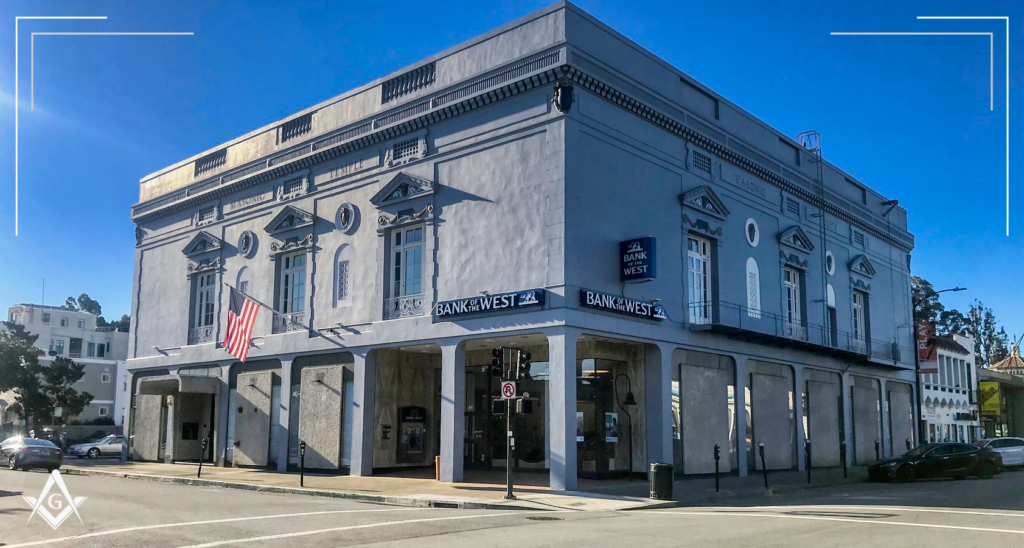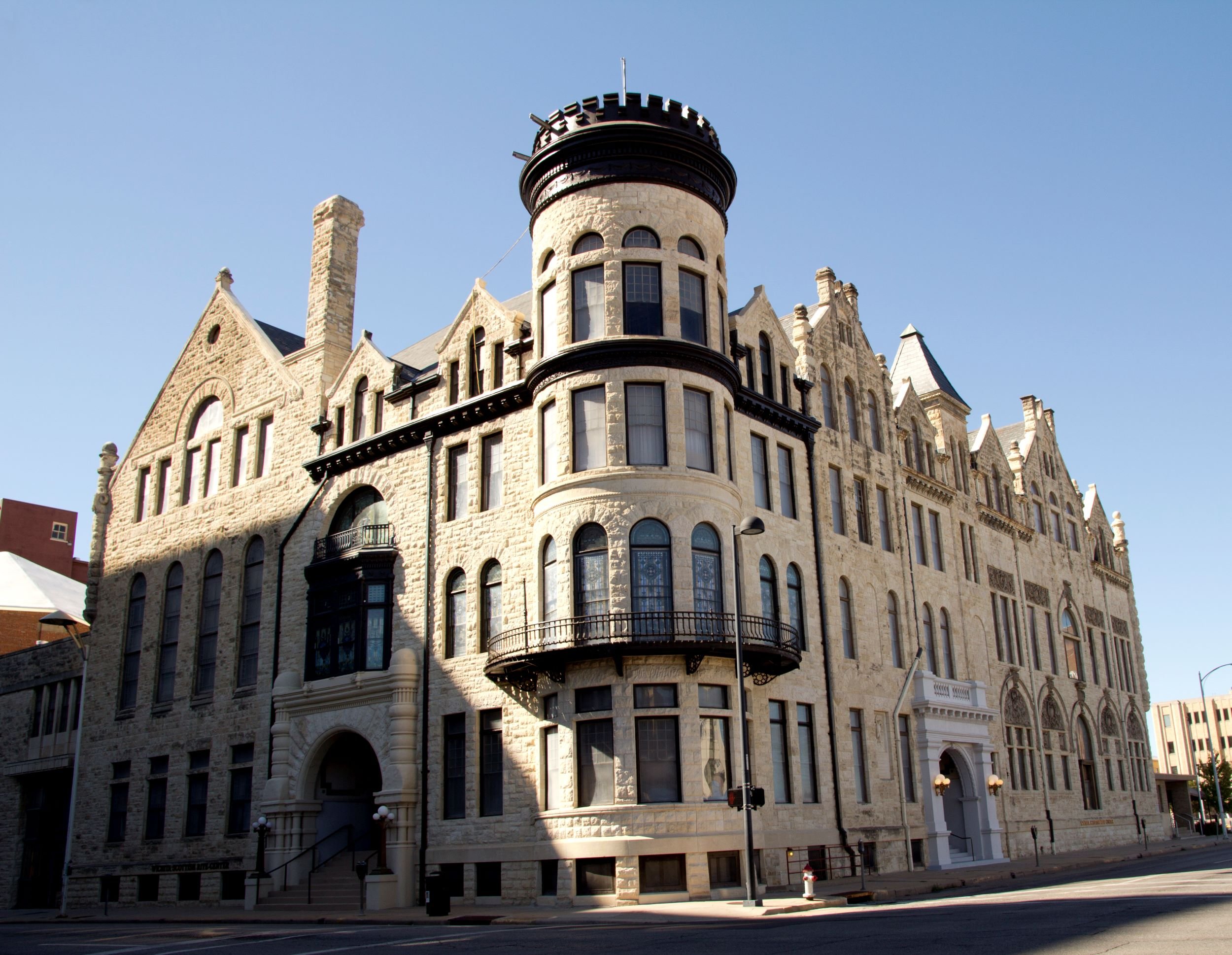Freemasons Hall
The Haverhill Masonic Building
111 Merrimack Street, Haverhill, Massachusetts
Erected 1873. Remodeled 1916
Freemasons Hall, 111 Merrimack Street, Haverhill, Massahusetts
Early Masonic Meeting Places in Haverhill
The first meeting place of Merrimack Lodge (1802) was in Assembly Hall, on the northerly side of Water Street at its junction with what is now known as Lindel Street. From 1815 to 1818 the lodge occupied the hall over the bank, later returning to Assembly Hall.
Following the Anti-Masonic excitement Merrimack’s charter was restored on November 9th, 1851. A year from that date the first meeting was held. The meeting place was in a hall, afterwards known as Odd Fellows Hall, over the vestry of the Centre Church on Vestry Street. It was occupied for about five years.
In 1857 a new Masonic hall was established on the west side of Fleet Street, it being the building later occupied by the Twentieth Century Bakery. The alley on the North side was known as Masonic Court.
"For several years our members have been somewhat dissatisfied with the situation and surroundings of our present hall, being literally surrounded by stables, liquor saloons and other objectionable features." On June 24, 1873, the corner-stone of the present Masonic Temple [northeast corner of Merrimack and How Streets] was laid by the Grand Lodge in simple and imposing form. The box deposited under the corner-stone contained matters of civic and Masonic interest and the trowel used by Sereno D. Nickerson, Grand Master, is in possession of the Lodge. The first meeting of the Lodge in the new Temple took place March 3rd, 1874, in the small hall, the large hall being used a few weeks later, on April 14th.
Haverhill Masonic Building 1893. From map of Haverhill by O.M. Bailey, Boston, 1893. The Valley of the Merrimack has used this building as its main place of meeting since the Valley was instituted in 1892.
Freemasons Hall Remodeled 1916
From New England Craftsman, Vol. XII, No. 3, December 1916, Page 89:
One of the most interesting events in the Masonic history of Haverhill, Mass., occurred Monday, Dec. 4th, in the dedication of their remodeled temple. The changes and improvements in the temple, both interior and exterior, make it practically a new building.
The dedication of the remodeled temple was conducted by Grand Master Melvin M. Johnson, assisted by other officers of the Grand Lodge. Owing to the limited accommodations, the dedicatory exercises were confined to the members of Merrimack and Saggahew Lodges, the two lodges located in Haverhill, the combined membership of which is nearly 900. These, with the members of the Grand Lodge, completely filled the apartments. Previous to the exercises the Grand Master with his suite were handsomely entertained by District Deputy Grand Master Benjamin B. Gilman at his home, "Overlook Farm." He was assisted by Past Master Frederick H. Tilton of Saggahew Lodge who has served Rt. Wor. Brother Gilman as Marshal at his official visits to the lodges in his district.
The officers of both Merrimack and Saggahew Lodges participated in the opening and closing exercises. In his address following the very formal and solemn dedication of the building and its halls, Grand Master Johnson delivered an eloquent address in which he reviewed the history of freemasonry and spoke of its philosophy and its mission.
He spoke especially of the part that freemasonry played in the establishing of the constitutional government of the United States and how its ideals had been imparted to it as its contribution in the building up of the American civilization.
The Grand Master was frequently forced to pause by the applause that greeted his utterances. When the exercises were ended and the lodges closed the members thronged the banquet hall, where a buffet lunch was served.
The changes in the Temple have considerably increased the capacity of the lodge room,—originally it seated about 250. It now accommodates 330. The lodge room is handsomely furnished and decorated, a special feature being the vaulted ceiling with gold stars on a blue sky.
Pediments emphasizing the Roman have been constructed over the different stations. The walls are finished to represent caen stone with the joints showing. The lighting is all from the cornice and entirely indirect. The severity of the walls is relieved by fluted pilasters with Doric capitals.
The lodge room has been carpeted in a pleasing shade of blue and upholstery and benches made to conform.
The grand new $7500 organ, with its 1100 pipes, electrically controlled, was installed by the Estey Organ Company of Brattleboro, Vermont. The Boston office of the company, at 120 Boylston Street, is managed by Brother Charles R. Putnam, a well known member of the Craft and Past Commander of Cambridge Commandery, K. T.
The seating capacity of the banquet hall on the top floor remains unchanged. Its appearance has been greatly enhanced by the change in the roof and the installation of new lighting fixtures. A small stage has been constructed above the staircase for the use of musicians and other entertainers.
The armory of Haverhill Commandery Knights Templar has been made 12 ft. longer and 26 new double lockers put in of black walnut to match those already in use. Originally there were 122 such lockers and with the additional ones the armory now accommodates 296 members.
The full committee on reconstructing the building is composed of Charles P. Sumner and Joseph A. Dalrymple from Saggahew Lodge, Nelson C. Hunt and Albert G. Harding of Merrimack Lodge. Lamont H. Chick and Benjamin B. Gilman from Pentucket Chapter, Edward A. Fitts and Charles C. Chase from Haverhill Council, Daniel C. Hunt and George W. Palmer from Haverhill Commandery and Fred D. McGregor and Charles N. Kelly from the Merrimack Lodge of Perfection. Charles C. Chase was chosen chairman and Edward A. Fitts clerk and treasurer of the committee. These two with Benjamin B. Gilman were named as a subcommittee on the remodelling of the building, while Daniel C. Hunt, Joseph A. Dalrymple, Nelson J. Hunt, Albert G. Harding and George W. Palmer were chosen a committee on the furnishings.
Following the dedicatory exercises opportunity was afforded for inspection of the remodeled Temple. All agreed in commending its new attractions and enlarged accommodations.
Source: masonicgenealogy.com
Other Scottish Rite Meeting Places Around the United States
Here’s a selection of photos that we’ve run across in our internet travels.
Valley of Alexandria, Virginia
Valley of Boston, Massachusetts
Valley of Burlingame, Calif.
Valley of Chicago, Bloomington, Illinois
Valley of Dallas, Texas
Valley of Dayton, Ohio, courtesy Nytend, Wikipedia
Valley of Des Moines, Iowa
Valley of Southern Illinois, East St. Louis, Ill.
Valley of Fort Smith, Ark.
Valley of Houston, Texas
Valley of Joplin, Missouri
Valley of Kansas City, Missouri. Courtesy Kansas City Public Library
Valley of Lowell, Mass.
Valley of Madison, Wisconsin
Valley of Miami, Fla.
Valley of Mobile AL
Valley of Olympia, Washington
Valley of Omaha, Neb.
Valley of Orlando, Fla.
Valley of Philadelphia, Pennsylvania
Valley of Pocatello, Idaho
Valley of Savannah, Ga.
Valley of Salem, Massachusetts
Valley of Pueblo/Colorado Springs, Colorado Springs , Colo.
Valley of Springfield, Massachusetts (Holyoke, Mass.)
Valley Witchita, Kans.
Valley of Worcester, Massachusetts





























